- Editorial
- Shibu Natesan Speaks on Protest Art
- Rising Against Rambo: Political Posters Against US Aggression
- Transient Imageries and Protests (?)
- The Inner Voice
- Bhopal – A Third World Narrative of Pain and Protest
- Buddha to Brecht: The Unceasing Idiom of Protest
- In-between Protest and Art
- Humour at a Price: Cartoons of Politics and the Politics of Cartoons
- Fernando Botero's Grievous Depictions of Adversity at the Abu Ghraib
- Up Against the Wall
- Rage Against the Machine: Moments of Resistance in Contemporary Art
- Raoul Hausmann: The Dadaist Who Redefined the Idea of Protests
- When Saying is Protesting -
- Graffiti Art: The Emergence of Daku on Indian Streets
- State Britain: Mark Wallinger
- Bijon Chowdhury: Painting as Social Protest and Initiating an Identity
- A Black Friday and the Spirit of Sharmila: Protest Art of North East India
- Ratan Parimoo: Paintings from the 1950s
- Mahendra Pandya's Show 'Kshudhit Pashan'
- Stunning Detours of Foam and Latex Lynda Benglis at Thomas Dane Gallery, London
- An Inspired Melange
- Soaked in Tranquility
- National Museum of Art, Osaka A Subterranean Design
- Cartier: "Les Must de Cartier"
- Delfina Entrecanales – 25 Years to Build a Legend
- Engaging Caricatures and Satires at the Metropolitan Museum
- The Mesmerizing World of Japanese Storytelling
- The Metropolitan Museum of Art Exhibiting Lyrical Visions: Paintings from North India
- Random Strokes
- Asia Week at New York
- Virtue of the Virtual
- What Happened and What's Forthcoming
- Art Events Kolkata, March – April 2012
- Mumbai Art Sighting
- Art Bengaluru
- Delhi Dias
- Preview, April, 2012 – May, 2012
- In the News, April 2012
- Cover
ART news & views
Ratan Parimoo: Paintings from the 1950s
Issue No: 28 Month: 5 Year: 2012
by Sandhya Bordewekar
Prof. Ratan Parimoo is a trained painter and a highly respected art historian. In 1951, he came to Baroda, a lad of 15, from his native Srinagar, to study painting under Prof. N S Bendre. In 1960, he travelled to England on the prestigious Commonwealth Scholarship, to study art history. Art History then claimed him as her own, and has never really been able to let him go. Even today, 50 years after he plunged into the study of art history, and with almost 20 books in the subject to his credit, he continues as the Director of the L D Museum and N C Mehta Gallery in Ahmedabad, doing path-breaking work in the field of art historical research.
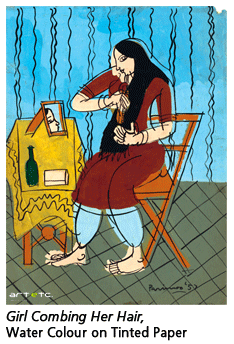 But Parimoo is also a painter and, personally, I think he has made his best work from 1955 to 1960. The Marvel Art Gallery, Ahmedabad, has put together these early works in a show titled Revisiting 1950s with Ratan Parimoo and brought out a detailed catalogue on the occasion. These works have been divided into three parts that chart the growth of Parimoo the Painter, as he reminisces about the homeland left behind and the wonders that his new home, defined by his education and profession, exposes him too. The works also reveal the efforts of the 'student' artist as he tries to put into practice the points of reference of physical art-making that he has learnt at art school sketching exercises, creating forms in flowing lines, making compositions using the Law of Frontality, projecting emotions through colours much like the Fauvists, schematic compositions as seen in traditional Indian paintings such as scrolls, using the dynamic calligraphic lines of Jain miniatures and colour planes, experimenting with layouts of Tibetan thangka paintings, arranging forms in space using the two-dimensional principles of pictorial language as seen in Egyptian pyramidal murals as well as Jain miniatures, and even his initial forays into using cubistic and abstract elements in figurative representation.
But Parimoo is also a painter and, personally, I think he has made his best work from 1955 to 1960. The Marvel Art Gallery, Ahmedabad, has put together these early works in a show titled Revisiting 1950s with Ratan Parimoo and brought out a detailed catalogue on the occasion. These works have been divided into three parts that chart the growth of Parimoo the Painter, as he reminisces about the homeland left behind and the wonders that his new home, defined by his education and profession, exposes him too. The works also reveal the efforts of the 'student' artist as he tries to put into practice the points of reference of physical art-making that he has learnt at art school sketching exercises, creating forms in flowing lines, making compositions using the Law of Frontality, projecting emotions through colours much like the Fauvists, schematic compositions as seen in traditional Indian paintings such as scrolls, using the dynamic calligraphic lines of Jain miniatures and colour planes, experimenting with layouts of Tibetan thangka paintings, arranging forms in space using the two-dimensional principles of pictorial language as seen in Egyptian pyramidal murals as well as Jain miniatures, and even his initial forays into using cubistic and abstract elements in figurative representation.
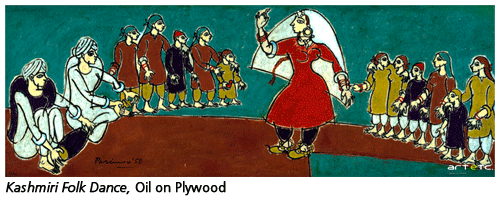
Maej Kashir (Mother Kashmir) form the first part of the series and obviously depict memories of Kashmir that flood the mind of young Parimoo, the student of painting, sweating it out in hot and dry Baroda! These are amongst his most wonderful works -- fresh, innocent, and vibrant with story-telling. Here is the artist, brimming with enthusiasm trying out the various skills and methods and tricks he has learnt in the craft of painting during the course of his study, and struggling to translate those techniques into magical and emotionally charged works of art, as best as he can. The alluring landscapes of the Kashmir valley, its serene lakes with the shikara-s and lined with statuesque poplars and chinar trees, golden rice fields besides gurgling streams, and bustling bazaars and mohalla-s with the tonga-s, are delineated in patches of liquid colour contrasted with differently coloured sharply linear outlines; they speak eloquently of a peaceful land suffused with happy memories of childhood and growing up. Parimoo is able to successfully evoke just that tinge of nostalgia, without any overt sentimentalism, that make these works a delight to look at.
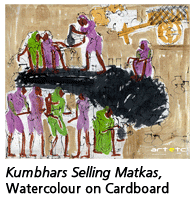
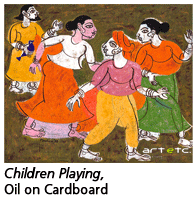
 Experiences of Indian Life I forms the second part and these paintings explore subjects based on the artist's direct experiences of life and environment in and around Baroda. From dipping into the treasure-trove of memories, the artist now explores the sights and sounds of a new location in which he is young and alone. The railway station, for instance, allows him to explore the paradoxical notion of 'waiting and movement', the linear structure of the vegetable markets that he sees for the first time in the plains finds expression in a schematic format, and the delight of visiting the zoo for animal study is immediately transformed into an excited virtual tour, the simple red lines indicating the barriers between the animals and visitors. The almost ten-feet long horizontal scroll, Marriage Procession, made in 1957 with oil on canvas, was quite an ambitious work, inspired by such processions along with band-baaja that he witnessed often in Baroda (probably more emotionally inspired as well since he had fallen in love with fellow artist, Naina Dalal, by then. He eventually used the sketch for his wedding invitation card!).
Experiences of Indian Life I forms the second part and these paintings explore subjects based on the artist's direct experiences of life and environment in and around Baroda. From dipping into the treasure-trove of memories, the artist now explores the sights and sounds of a new location in which he is young and alone. The railway station, for instance, allows him to explore the paradoxical notion of 'waiting and movement', the linear structure of the vegetable markets that he sees for the first time in the plains finds expression in a schematic format, and the delight of visiting the zoo for animal study is immediately transformed into an excited virtual tour, the simple red lines indicating the barriers between the animals and visitors. The almost ten-feet long horizontal scroll, Marriage Procession, made in 1957 with oil on canvas, was quite an ambitious work, inspired by such processions along with band-baaja that he witnessed often in Baroda (probably more emotionally inspired as well since he had fallen in love with fellow artist, Naina Dalal, by then. He eventually used the sketch for his wedding invitation card!).
 Experiences of Indian Life II comprises the third and last part of this series. The paintings here continue to be concerned with Baroda, but also move out as Parimoo travels to Ajanta, Khajuraho, Ahmedabad and the interior villages of Gujarat. The painting titled Ajanta Valley is particularly enchanting, the horse-shoe shaped valley comes alive in the brilliant golden-yellow highlighted by the dark-brownish-black frame of the surrounding hills and the deep blue of the monsoon-drenched rivulet settled in its lap. The aerial view of the valley embraces its vast breadth, allowing the artist to present pockets of activity all over, much like the layout of the thangka that presents several happenings at once in different spaces. In contrast, the work, Khajuraho Temple Complex is presented almost as an abstracted landscape of steps, shikhara-s and mandapa-s with stick figures moving about them, interspersed with green patches of trees and brown ones of the soil, and crowned with the orange glow of the setting sun. This part also features monkeys and peahens (which he saw for the first time at Baroda), donkeys, bullocks, cows, buffaloes, with the artist trying to portray their essential qualities as they sit around in groups, preen, graze, work, or are driven home. For a suite of paintings that he made on the very popular festival of kite-flying which he experienced in Gujarat, he actually used kite-paper to create collages wherein the brightly coloured and almost translucent kite paper replaces paint.
Experiences of Indian Life II comprises the third and last part of this series. The paintings here continue to be concerned with Baroda, but also move out as Parimoo travels to Ajanta, Khajuraho, Ahmedabad and the interior villages of Gujarat. The painting titled Ajanta Valley is particularly enchanting, the horse-shoe shaped valley comes alive in the brilliant golden-yellow highlighted by the dark-brownish-black frame of the surrounding hills and the deep blue of the monsoon-drenched rivulet settled in its lap. The aerial view of the valley embraces its vast breadth, allowing the artist to present pockets of activity all over, much like the layout of the thangka that presents several happenings at once in different spaces. In contrast, the work, Khajuraho Temple Complex is presented almost as an abstracted landscape of steps, shikhara-s and mandapa-s with stick figures moving about them, interspersed with green patches of trees and brown ones of the soil, and crowned with the orange glow of the setting sun. This part also features monkeys and peahens (which he saw for the first time at Baroda), donkeys, bullocks, cows, buffaloes, with the artist trying to portray their essential qualities as they sit around in groups, preen, graze, work, or are driven home. For a suite of paintings that he made on the very popular festival of kite-flying which he experienced in Gujarat, he actually used kite-paper to create collages wherein the brightly coloured and almost translucent kite paper replaces paint.
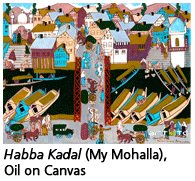
There are not many works made by Parimoo in the 1955-60 period that are easily available. There is one extraordinary work, Habba Kadal (My Mohalla) that he has himself made as a second version in 2011. It offers an enigmatic view of a busy area of Srinagar on the banks of the Jhelum with its ghat-s, temples, mosques, and quaint river-side architecture. The painting is split at the centre with the bridge on which are tonga-s, as well as a car or two. Shikara-s throng the river banks and a lone policeman directs traffic! When will we ever experience a Srinagar of such loveliness, calm and peace?